Source: J Drugs Dermatol. 2019;18(1):24-27.
May Elgash BS, Ncoza Dlova MBChB FCDerm PhD, Temitayo Ogunleye MD, Susan C. Taylor MD
Skin of Color Update 2019 faculty Susan C. Taylor, MD and colleagues published a paper in the January 2019 issue of the Journal of Drugs in Dermatology on seborrheic dermatitis in skin of color. Read the abstract below or login in to JDD for the full manuscript.
Abstract: Seborrheic dermatitis is a common, relapsing, inflammatory skin condition of unclear etiology. The Malassezia yeast genus are believed to play a role. Seborrheic dermatitis commonly affects areas of the skin with high sebum production, including the scalp, nasolabial folds, glabella, eyebrows, beard, ears, retroauricular skin, sternum, and other skin folds. Seborrheic dermatitis may present differently in individuals with skin of color. Darker-skinned individuals may present with scaly, hypopigmented macules and patches in typical areas of involvement. Arcuate or petal-like patches may be seen, specifically termed petaloid seborrheic dermatitis. Children of color often do not experience the classic “cradle cap” appearance of seborrheic dermatitis, and have erythema, flaking, and hypopigmentation of the affected areas and folds of skin. Seborrheic dermatitis tends to respond well to conventional treatments, although it tends to recur. Skin of color patients may require a modified treatment approach which takes into account differences in hair texture and hair washing frequency. This paper aims to highlight these differences to help reduce disparities in the management of seborrheic dermatitis in patients of color. To read the full manuscript with your JDD subscription, click here.


